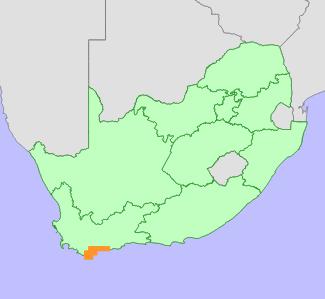|
Scientific Name | Leucospermum truncatum (H.Buek ex Meisn.) Rourke |
Higher Classification | Dicotyledons |
Family | PROTEACEAE |
Common Names | Limestone Pincushion (e) |
National Status |
Status and Criteria | Near Threatened B1ab(iii)+2ab(iii) |
Assessment Date | 2019/08/13 |
Assessor(s) | A.G. Rebelo, H. Mtshali & L. von Staden |
Justification | Leucospermum truncatum has a restricted distribution range, with an Extent of Occurrence of 2450 km², and an Area of Occupancy of 648-652 km². A continuing decline is inferred from increasing competition from alien invasive plants, but this species is still abundant within its habitat, and is known from more than 10 locations. Therefore it nearly meets the thresholds for Vulnerable under criterion B. |
Distribution |
Endemism | South African endemic |
Provincial distribution | Western Cape |
Range | Leucospermum truncatum has a limited distribution range on the southern coast of the Western Cape, where it occurs from the Soetanysberg on the Agulhas Plain to the coastal flats south of Riversdale at Vermaaklikheid. |
Habitat and Ecology |
Major system | Terrestrial |
Major habitats | Canca Limestone Fynbos, De Hoop Limestone Fynbos, Agulhas Limestone Fynbos |
Description | It occurs in limestone fynbos on coastal flats, 0-250 m. Mature individuals are killed by fires, and only seeds survive. Seeds are released after ripening, and dispersed by ants to their underground nests, where they are protected from predation and fire. It is pollinated by birds. |
Threats |
| A very small proportion (3%) of this species' habitat has been lost to coastal development and agriculture, but there is no significant ongoing habitat loss. More concerning is the fact that at least 20% of remaining limestone fynbos is infested with alien invasive plants, that are outcompeting native species both inside and outside protected areas.
There has been efforts to clear invasive plants in De Hoop Nature Reserve and the Agulhas National Park, but eradication is proving difficult due to persistent seed banks, from which invasive wattles regenerate profusely following natural wildfires. |
Population |
This species is locally abundant, and is usually encountered as dense, extensive and isolated stands. A continuing decline is inferred from increasing competition from alien invasive plants that are displacing native species, particularly outside protected areas.
|
Population trend | Decreasing |
Assessment History |
Taxon assessed |
Status and Criteria |
Citation/Red List version | | Leucospermum truncatum (H.Buek ex Meisn.) Rourke | NT B1ab(iii)+2ab(iii) | 2020.1 | | Leucospermum truncatum (H.Buek ex Meisn.) Rourke | Least Concern | Raimondo et al. (2009) | |
Bibliography |
Goldblatt, P. and Manning, J.C. 2000. Cape Plants: A conspectus of the Cape Flora of South Africa. Strelitzia 9. National Botanical Institute, Cape Town.
Raimondo, D., von Staden, L., Foden, W., Victor, J.E., Helme, N.A., Turner, R.C., Kamundi, D.A. and Manyama, P.A. 2009. Red List of South African Plants. Strelitzia 25. South African National Biodiversity Institute, Pretoria.
Rebelo, T. 2001. Sasol Proteas: A field guide to the proteas of southern Africa. (2nd ed.). Fernwood Press, Vlaeberg, Cape Town.
|
Citation |
| Rebelo, A.G., Mtshali, H. & von Staden, L. 2019. Leucospermum truncatum (H.Buek ex Meisn.) Rourke. National Assessment: Red List of South African Plants version 2024.1. Accessed on 2025/11/03 |
 Comment on this assessment
Comment on this assessment

